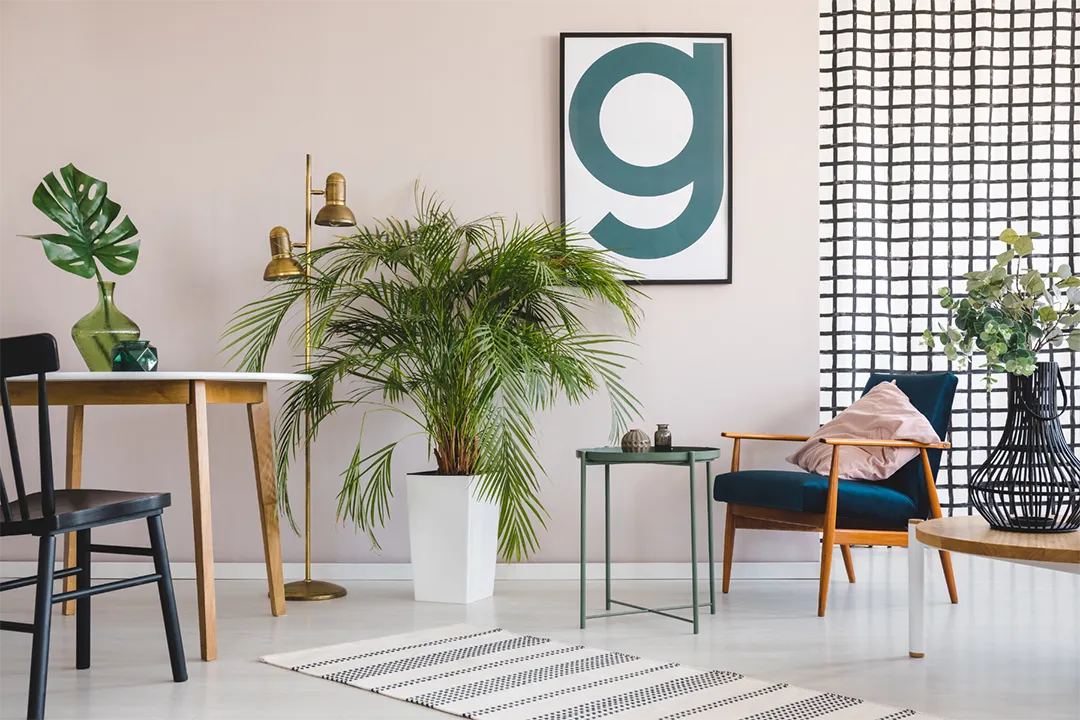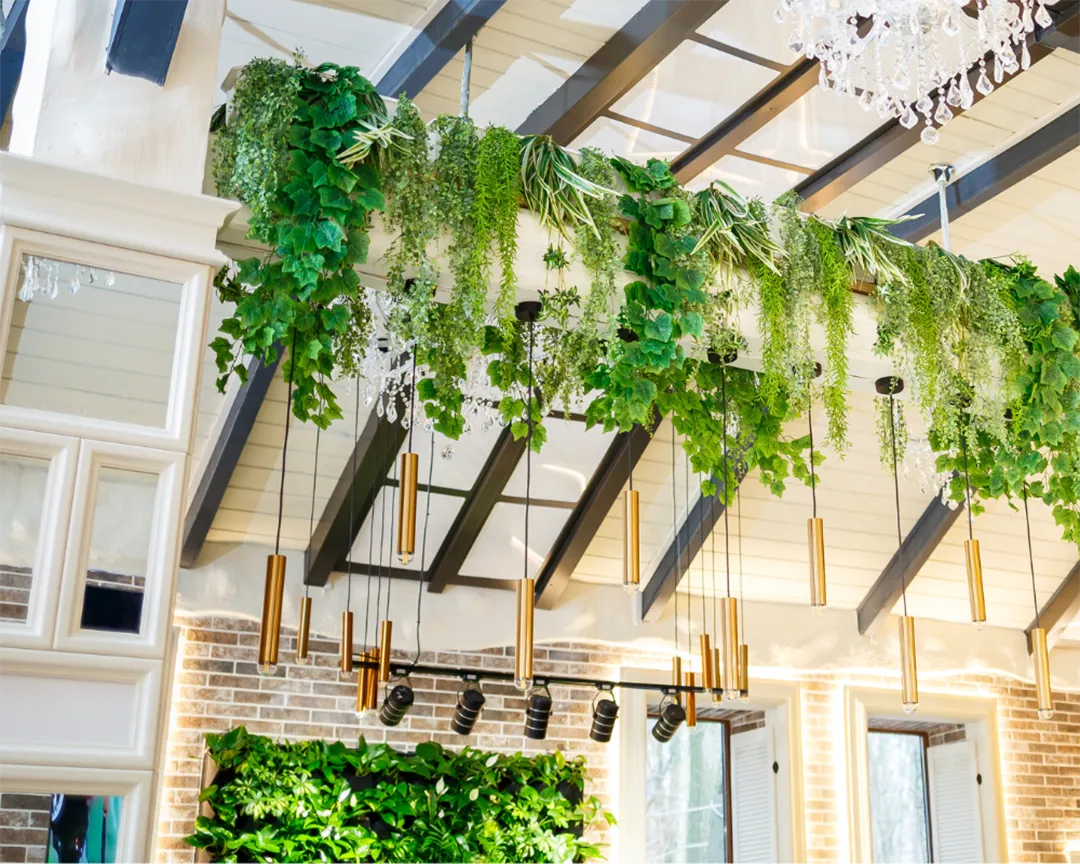
Indoor plants are a great way to enhance homes and offices – they add beauty and improve health. But real and artificial plants have their differences. This article examines the pros and cons of both options, helping you decide which best suits your space and lifestyle.
Artificial indoor plants are durable and safe for those with allergies
Let’s start with the advantages of faux indoor plants. Artificial plants have remained popular for several reasons. Firstly, they are low-maintenance and durable – an excellent choice for those who want the beauty of greenery without acquiring new gardening skills. Their durability means they can last for years with little effort, and only require occasional dusting to maintain their fresh look. And let’s not forget, they stay vibrant year-round! Artificial plants are ideal for dark spaces and those with busy schedules because they don’t require water, sunlight, or pruning. If you want plants to line the tops of your cabinets or sit in the shadowy corners of your bedroom, artificial plants might be the perfect fit. They liven up spaces without any worries about their health or survival. Artificial indoor plants are an excellent choice for allergy sufferers, as they offer a pollen-free, sap-free, and fragrance-free alternative to natural plants. Because of their hypoallergenic qualities, artificial plants are ideal for schools and healthcare offices where visitors might have autoimmune sensitivities, ensuring spaces remain accessible to all. Additionally, faux plants don’t require real soil, which eliminates the possibility of stirring up dust and natural irritants when repotting or caring for natural plants over the years. Artificial plants are perfect for those who want the aesthetic beauty of greenery without risking the sniffles.
Real or faux, we’ve got the perfect fit
Whether you prefer low-maintenance artificial plants or the health benefits of natural greenery, we can help create a beautiful, customized indoor oasis that fits your lifestyle. Get Started with Plant Solutions

What you need to know before buying artificial indoor plants
Despite all of their perks, artificial plants don’t provide the same health advantages as real indoor plants—they don’t absorb toxins from the air, increase oxygen, or produce the same mental health benefits that caring for natural plants can. Another false belief is that they are absolutely maintenance-free. Truth be told, indoor artificial plants can fade, lose their original vibrancy, or become damaged over time. Because replacements are expensive, it’s important to look them over every few weeks to maintain like-new condition. Be sure they’re not losing color from too much direct sun exposure, and reposition them as needed. Like regular indoor plants and all room decorations, they will inevitably accumulate dust and require regular cleaning to avoid particle build-up and staining. There’s one last item to consider before buying faux plants: some people may find artificial plants slightly less upscale than real indoor plants. Their appearance becomes more realistic every year, but with all replica items, there are bound to be some minor imperfections when seen up close or touched. If you’re maintaining a luxurious space that boasts sophistication and elegance, mix both artificial and real plants. Place natural indoor plants within reach in well-lit spaces – tabletop vases, lobby planters, and eye-level living walls. Arrange faux indoor plants in areas that are less likely to draw interactive touch – hanging planters, elevated plant displays, and out-of-reach MossWall Art™. Custom Faux Botanicals are designed and created specifically for your space by an experienced biophilic artist. These artificial plant arrangements are visually identical to real plants and offer UV protection so they can be featured outside.

Natural indoor plants provide health benefits but require more care
Natural indoor plants offer significant rewards for those committed to a healthier, cleaner living environment. They improve indoor air quality by filtering out toxins and increasing oxygen. Natural plants also increase humidity, which benefits both skin and respiratory health. This creates a healthier space for everyone who enters your home or office. Real plants bring a sensory richness that fake plants can’t fully match. Their scent, texture, and variety appeal to our senses and calm our minds. Studies show that caring for real indoor plants contributes to emotional wellbeing and reminds us to care for ourselves. Watching a plant is rewarding, and many people find that nurturing plants helps them feel grounded. Connecting with forms nature that’s alive acts as a natural mood-booster and reminds us to be more present throughout the day. This is the power of biophilic design. What challenges accompany maintaining live indoor plants? Real plants require more care than their artificial counterparts. Most of us know all plants need sunlight and water, but there will be some routine cleanup. Without regular pruning, indoor plants may become leggy, with long, weak stems and sparse foliage. This occurs as the plant focuses its energy on growing outward, beyond plant debris, rather than maintaining a balanced shape. Additionally, overgrown plants may compete with themselves for light and nutrients, leading to stunted growth or fewer blooms. Pruning helps maintain a plant’s shape, encourages new growth, and keeps it healthy and vibrant.
No matter your constraints, we’ll find indoor plants that fit your needs
Artificial and natural plants have different advantages, and both require some care. Artificial indoor plants are allergy-free, easy to maintain, and survive low-light environments, but natural plants offer greater health benefits, improve air quality, and boost well-being. Plant Solutions is here to help you select and maintain the perfect plants for your space. Contact us so we can get started – let’s bring nature indoors together!
Looking for a tailored greenery solution?
Fill out the form below to tell us about your space and preferences. Our team will recommend the best combination of artificial and natural plants to suit your unique needs.
